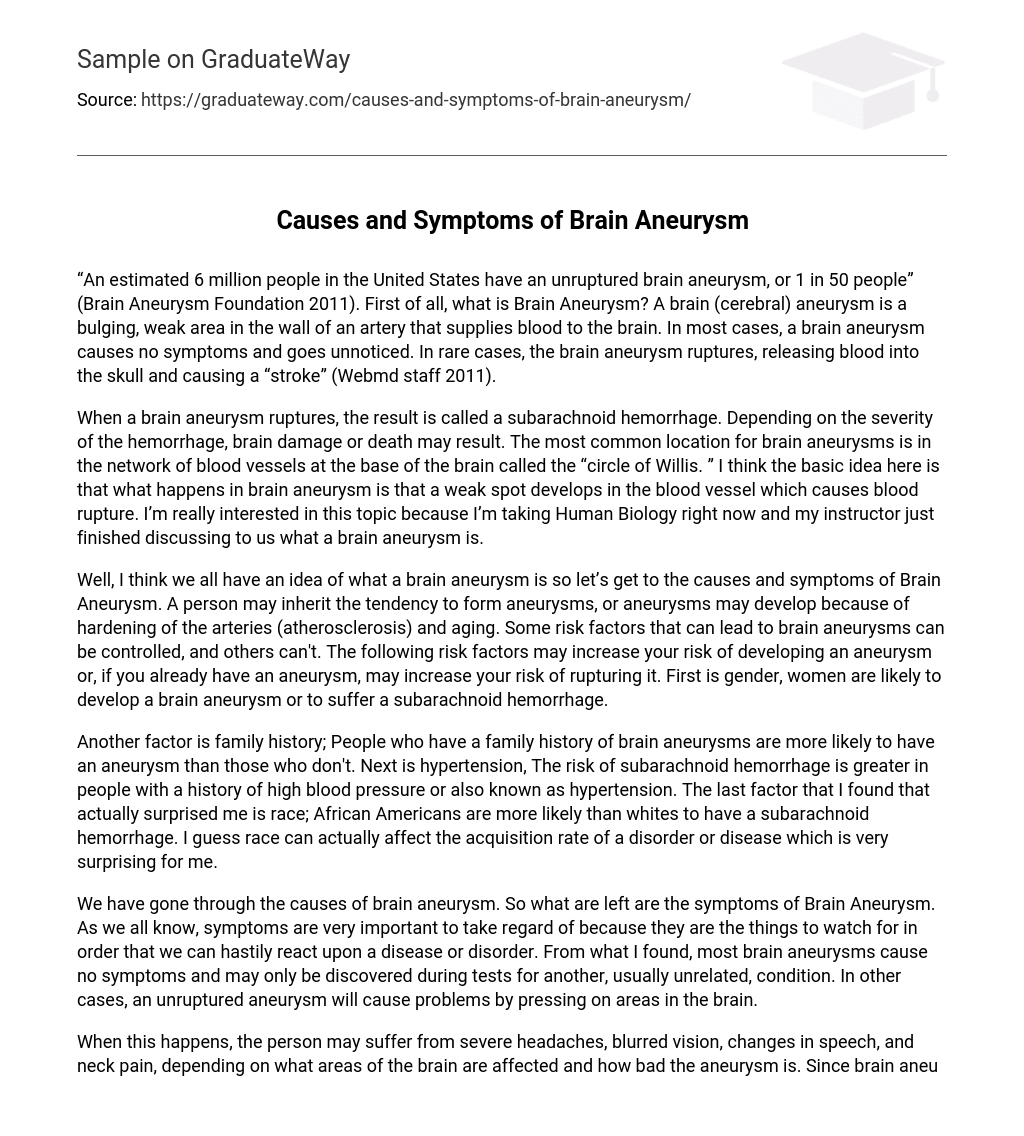“An estimated 6 million people in the United States have an unruptured brain aneurysm, or 1 in 50 people” (Brain Aneurysm Foundation 2011). First of all, what is Brain Aneurysm? A brain (cerebral) aneurysm is a bulging, weak area in the wall of an artery that supplies blood to the brain. In most cases, a brain aneurysm causes no symptoms and goes unnoticed. In rare cases, the brain aneurysm ruptures, releasing blood into the skull and causing a “stroke” (Webmd staff 2011).
When a brain aneurysm ruptures, the result is called a subarachnoid hemorrhage. Depending on the severity of the hemorrhage, brain damage or death may result. The most common location for brain aneurysms is in the network of blood vessels at the base of the brain called the “circle of Willis. ” I think the basic idea here is that what happens in brain aneurysm is that a weak spot develops in the blood vessel which causes blood rupture. I’m really interested in this topic because I’m taking Human Biology right now and my instructor just finished discussing to us what a brain aneurysm is.
Well, I think we all have an idea of what a brain aneurysm is so let’s get to the causes and symptoms of Brain Aneurysm. A person may inherit the tendency to form aneurysms, or aneurysms may develop because of hardening of the arteries (atherosclerosis) and aging. Some risk factors that can lead to brain aneurysms can be controlled, and others can’t. The following risk factors may increase your risk of developing an aneurysm or, if you already have an aneurysm, may increase your risk of rupturing it. First is gender, women are likely to develop a brain aneurysm or to suffer a subarachnoid hemorrhage.
Another factor is family history; People who have a family history of brain aneurysms are more likely to have an aneurysm than those who don’t. Next is hypertension, The risk of subarachnoid hemorrhage is greater in people with a history of high blood pressure or also known as hypertension. The last factor that I found that actually surprised me is race; African Americans are more likely than whites to have a subarachnoid hemorrhage. I guess race can actually affect the acquisition rate of a disorder or disease which is very surprising for me.
We have gone through the causes of brain aneurysm. So what are left are the symptoms of Brain Aneurysm. As we all know, symptoms are very important to take regard of because they are the things to watch for in order that we can hastily react upon a disease or disorder. From what I found, most brain aneurysms cause no symptoms and may only be discovered during tests for another, usually unrelated, condition. In other cases, an unruptured aneurysm will cause problems by pressing on areas in the brain.
When this happens, the person may suffer from severe headaches, blurred vision, changes in speech, and neck pain, depending on what areas of the brain are affected and how bad the aneurysm is. Since brain aneurysm often does not cause any symptoms, many are discovered in people who are being treated for a different condition. A CT-scan could definitely help identify bleeding in the brain. Sometimes a lumbar puncture may be used if your doctor suspects that you have a ruptured cerebral aneurysm with a subarachnoid hemorrhage. In conclusion, Brain aneurysm is really hard to detect since the symptoms aren’t really there.
So if you experience even a slight headache or dizziness in a regular basis, I think it is best to have a quick check up from a doctor. Also, what people don’t realize is that having regular checkups are really important since there are cases like this where symptoms don’t really show till you have it already.
References:
- Webmd, S. (2011, January 07). Brain aneurysm – topic overview. Retrieved from http://www. webmd. com/brain/tc/brain-anurysm-topic-overview.
- Brain Aneurysm FOundation Staff. (2011). Understanding: Brain aneurysm statistics and facts. Retrieved from http://www. bafound. org/node/124





